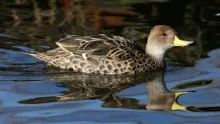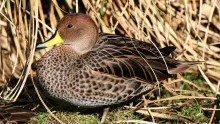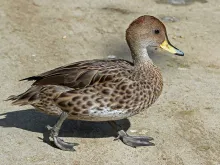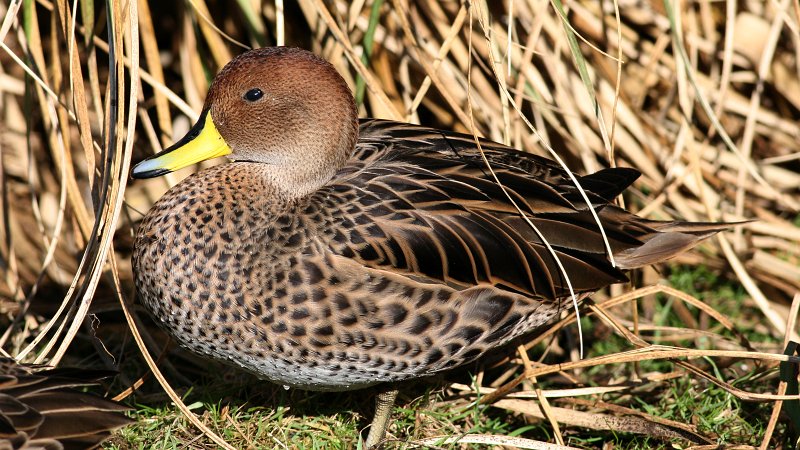
Yellow-billed pintail (Anas georgica)
Species name
- Dutch name:
- Geelsnavel pijlstaart (chili)
- English name:
- Yellow-billed pintail
- German name:
- Spitzschwanzente
- French name:
- Canard à queue pointue
- Scientific name:
- Anas georgica
Scientific classification
- Order:
- Anseriformes
- Family:
- Anatidae
- Onderfamilie:
- Anatinae
- Genus:
- Anas
Description
- Description:
Anas georgica spinicauda
Male:
Has a brown head and neck. The bill is yellow with a black tip and a black stripe down the middle. The tail is brownish and pointed. The upper wing is grayish-brown, and the secondaries are blackish-green. The rest of the body is buffish brown with varying size black spots.Female:
The female is almost similar to male. She has duller yellow bill with pale grey to black tip, and duller dark brown speculum. The underparts can be slightly whiter..Juvenile:
Resembles female but it has streaked breast and underparts. And slightly less red brown.Anas georgica georgica
Male:
As (A.g. spinicauda ),But smaller stockier. Overall plumage considerably darker, more red brown, and heavily spotted, especially on underparts, with belly little differentiated from breast and flanks. Head rounder, with shorter bill slightly up turned.
Female:
The female is almost similar to male. She has duller yellow bill with pale grey to black tip, and duller dark brown speculum. The underparts can be slightly whiter.Juvenile: Resembles female but it has streaked breast and underparts. And slightly less red brown.
Standard Measurements
- Body Length (cm):
- The male (drake) of the Yellow-billed pintail measures approximately 43-55 centimeters. The female measures approximately 43-55 centimeters.
- Body Weight (grams):
- The male will weight about 610-660 gram. The female will weight about 460-610 gram.
The weight is notoriously variable and can only be used as indication!
- Subspecies:
Known subspecies:
- Anas georgica georgica: South Georgia I.
- Anas georgica niceforoi: Formerly Andes of Colombia. Extinct ca 1952
- Anas georgica spinicauda: Highlands of s Colombia to Tierra del Fuego and Falkland Islands
- Habitat:
They should be provided with cover (including marginal pond cover) and loafing areas as well as water. A pen which is 50% water is suggested. The water may be shallow (i.e. no more than two feet deep is required), and muddy areas for dabbling in are also appreciated. These ducks are generally good in mixed collections, although the smaller and quieter species may be bullied. Territorial disputes between ducks of the same species may be avoided by keeping only one pair of each species in an enclosure, unless the area is very large. For a single pair of ducks a pen are of 50 to 100 square metres, depending on the size of duck, should be provided.
- Note:
Dabbling Ducks are generally hardy, easy to maintain and easy to breed. Shelter may be required by some of the smaller species in winter.
Yellow-billed pintails (Anas georgica spinicauda - Chilean pintail or Brown pintail) are winter-hardy and may be kept in a mixed collection with other ducks. These ducks (Anas georgica spinicauda - Chilean pintail) breed readily, using natural close ground cover for nesting, eggs laid April to May.
Most species are ground nesters and both close ground cover and ground level nest boxes should be provided. Hand-rearing is generally preferred, as these ducks are generally poor parents in captive conditions, particularly in enclosures shared with other waterfowl.
These ducks are prone to hybridization, particularly with closely related species, which should be kept apart from one another. Hybrids reported with Wood duck (Aix sponsa), Red-crested pochard (Netta rufina) and various Anas species.
- Breeding:
- The female Yellow-billed pintail usually lays from 4-10 creamy or pale pinkish eggs and incubates them for 26 days.
- Artificial incubating:
The ideal relative humidity for incubating most waterfowl eggs is 55% (ground nesters) and 40% (cavity nesters). The temperature is usually 37.4°C. Set ventilation as recommended by the incubator manufacturer. Eggs must be turned, either automatically or by hand, a minimum of 4 times a day. As the duckling develops there is a loss of water from the egg and the air sac gets bigger. In normal development of an egg with a 26 days incubation, the air sac occupies about a third of it three days earlier. Cleanliness is vital and ideally eggs should be moved to a separate hatcher at this point, where the humidity should be increased to 65% and even higher once they have pipped internally.
- Bird banding:
- Recommended closed leg band ring size for the Yellow-billed pintail is 9 mm.The leg band ring can only be applied on a young dabbling duck at around 12 days old.
- It doesn't matter what leg that you band, but it's good to have a consistent system. Suggested: Left leg = Female, Right leg = Male
- Maintenance food:
-


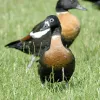


Floating full food for all sea ducks, green ducks, eider ducks and geese, especially in the moulting and breeding phase ideally suited. Packed with wholesome raw materials, natural vitamins and trace elements, this performance food with a protein content of 30% forms the basis for lifelong vitality.


